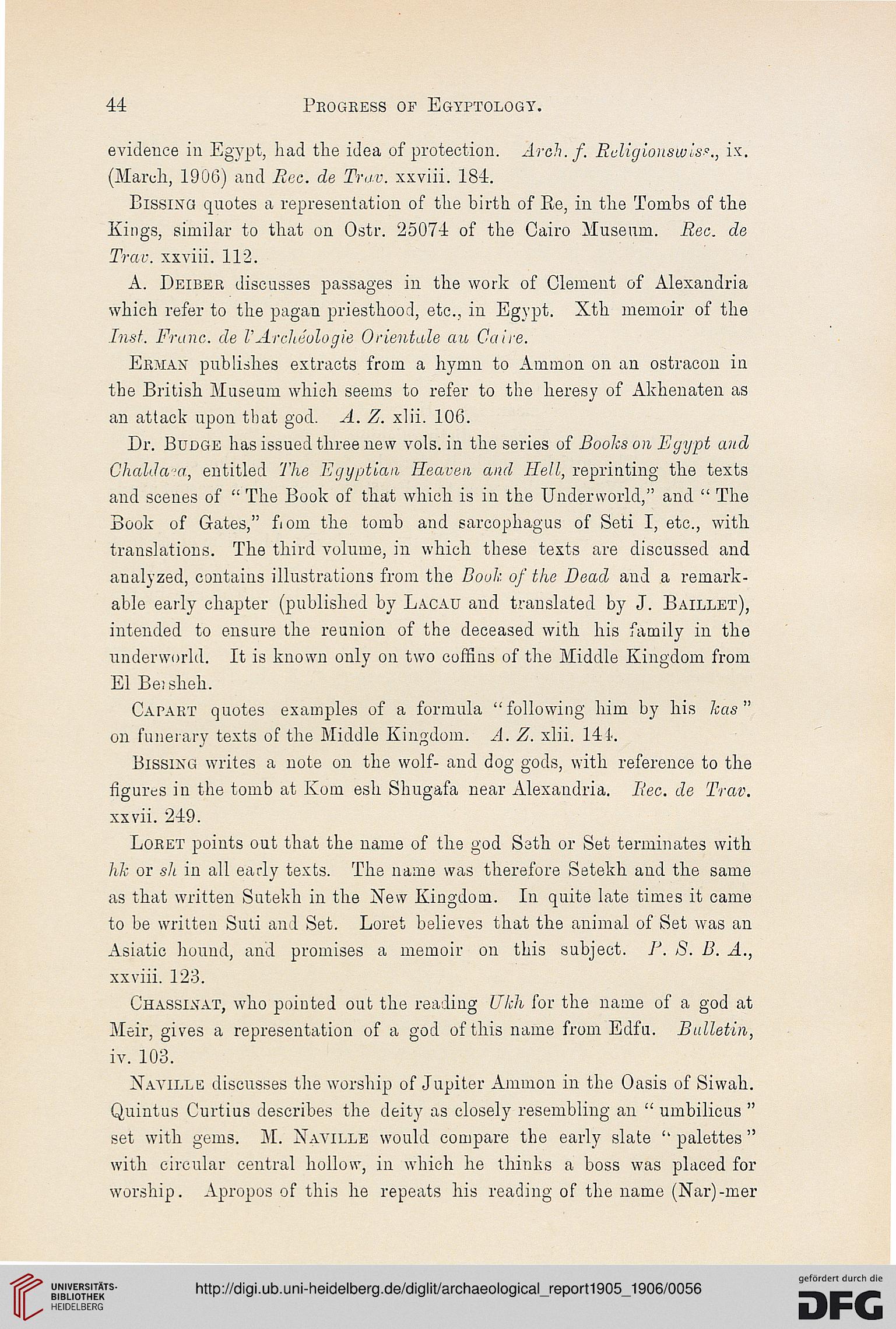44
Pkogeess of Egyptology.
evidence in Egypt, had the idea of protection. Arch.f. Religionswis"., is.
(March, 1906) and Roc. de Trav. xxviii. 184.
Bissixa quotes a representation of the birth of Re, in the Tombs of the
Kings, similar to that on Ostr. 25074 of the Cairo Museum. Rec. de
Trav. xxviii. 112.
A. Deiber discusses passages in the work of Clement of Alexandria
which refer to the pagan priesthood, etc., in Egypt. Xth memoir of the
Inst. Franc, de V Avcheologie Orientate au Cairo.
Eeman publishes extracts from a hymn to Amnion on an ostracon in
the British Museum which seems to refer to the heresy of Akhenaten as
an attack upon that god. A. Z. xlii. 106.
Dr. Budge has issued three new vols, in the series of Boohs on Egypt and
Chaldaja, entitled The Egyptian Heaven and Hell, reprinting the texts
and scenes of " The Book of that which is in the Underworld," and " The
Book of Gates," fiom the tomb and sarcophagus of Seti I, etc., with
translations. The third volume, in which these texts are discussed and
analyzed, contains illustrations from the Book of the Dead and a remark-
able early chapter (published by Lacau and trauslated by J. Baillet),
intended to ensure the reunion of the deceased with his family in the
underworld. It is known only on two coffins of the Middle Kingdom from
El Bejsheh.
Capabt quotes examples of a formula "following him by his has"
on funerary texts of the Middle Kingdom. A. Z. xlii. 144.
Bissixg writes a note on the wolf- and dog gods, with reference to the
figures in the tomb at Kom esh Shugafa near Alexandria. Hoc. do Trav.
xxvii. 249.
Loret points out that the name of the god Seth or Set terminates with
hh or sh in all early texts. The name was therefore Setekh and the same
as that written Sutekh in the New Kingdom. In quite late times it came
to be written Suti and Set. Loret believes that the animal of Set was an
Asiatic hound, and promises a memoir on this subject. P. S. B. A.,
xxviii. 123.
Chassixat, who pointed out the reading Ukh for the name of a god at
Meir, gives a representation of a god of this name from Edfu. Bulletin,
iv. 103.
Nayille discusses the worship of Jupiter Amnion in the Oasis of Siwah.
Quintus Curtius describes the deity as closely resembling an " umbilicus "
set with gems. M. Xayille would compare the early slate '' palettes "
with circular central hollow, in which he thinks a boss was placed for
worship. Apropos of this he repeats his reading of the name (Nar)-mer
Pkogeess of Egyptology.
evidence in Egypt, had the idea of protection. Arch.f. Religionswis"., is.
(March, 1906) and Roc. de Trav. xxviii. 184.
Bissixa quotes a representation of the birth of Re, in the Tombs of the
Kings, similar to that on Ostr. 25074 of the Cairo Museum. Rec. de
Trav. xxviii. 112.
A. Deiber discusses passages in the work of Clement of Alexandria
which refer to the pagan priesthood, etc., in Egypt. Xth memoir of the
Inst. Franc, de V Avcheologie Orientate au Cairo.
Eeman publishes extracts from a hymn to Amnion on an ostracon in
the British Museum which seems to refer to the heresy of Akhenaten as
an attack upon that god. A. Z. xlii. 106.
Dr. Budge has issued three new vols, in the series of Boohs on Egypt and
Chaldaja, entitled The Egyptian Heaven and Hell, reprinting the texts
and scenes of " The Book of that which is in the Underworld," and " The
Book of Gates," fiom the tomb and sarcophagus of Seti I, etc., with
translations. The third volume, in which these texts are discussed and
analyzed, contains illustrations from the Book of the Dead and a remark-
able early chapter (published by Lacau and trauslated by J. Baillet),
intended to ensure the reunion of the deceased with his family in the
underworld. It is known only on two coffins of the Middle Kingdom from
El Bejsheh.
Capabt quotes examples of a formula "following him by his has"
on funerary texts of the Middle Kingdom. A. Z. xlii. 144.
Bissixg writes a note on the wolf- and dog gods, with reference to the
figures in the tomb at Kom esh Shugafa near Alexandria. Hoc. do Trav.
xxvii. 249.
Loret points out that the name of the god Seth or Set terminates with
hh or sh in all early texts. The name was therefore Setekh and the same
as that written Sutekh in the New Kingdom. In quite late times it came
to be written Suti and Set. Loret believes that the animal of Set was an
Asiatic hound, and promises a memoir on this subject. P. S. B. A.,
xxviii. 123.
Chassixat, who pointed out the reading Ukh for the name of a god at
Meir, gives a representation of a god of this name from Edfu. Bulletin,
iv. 103.
Nayille discusses the worship of Jupiter Amnion in the Oasis of Siwah.
Quintus Curtius describes the deity as closely resembling an " umbilicus "
set with gems. M. Xayille would compare the early slate '' palettes "
with circular central hollow, in which he thinks a boss was placed for
worship. Apropos of this he repeats his reading of the name (Nar)-mer





